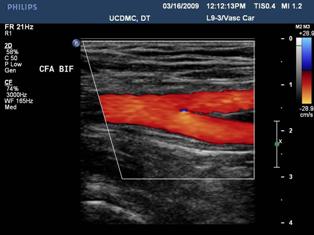Peripheral arterial duplex scanning
 Peripheral artery disease (PAD) is usually diagnosed on the basis of patients' symptoms and physical examination in the clinic, confirmed by evaluations in the Vascular Laboratory with pressure measurements and other non-invasive tests.
Peripheral artery disease (PAD) is usually diagnosed on the basis of patients' symptoms and physical examination in the clinic, confirmed by evaluations in the Vascular Laboratory with pressure measurements and other non-invasive tests.
Ultrasound duplex scanning can provide additional information that may guide therapeutic decisions. The location and severity of arterial narrowings and occlusions can be identified. The vascular technologist can map disease in lower-extremity segments with great accuracy — though duplex scanning is more time-consuming than other lower-extremity arterial studies.
The additional information from duplex scanning can help determine if arterial disease might be appropriately treated with an endovascular intervention. The type of treatment and the technical approach can be guided by the duplex scan findings. Information from the duplex scan can help patients be better informed about their options. Duplex scanning after intervention can provide objective information about the success of the procedure and serial follow-up examinations can identify recurrent problems at an early stage, sometimes prompting follow-up interventions.
Some preparation is needed. A complete lower extremity arterial evaluation includes duplex scanning of aorta and iliac arteries in the abdomen and pelvis. Gas in the intestinal tract can interfere with ultrasound evaluation. It is therefore best to have the examination performed after an overnight fast and it is important to avoid tobacco and caffeine prior to the test. A complete study can take up to two hours.
See also: Diseases, conditions and their treatments: Peripheral artery disease (PAD)
